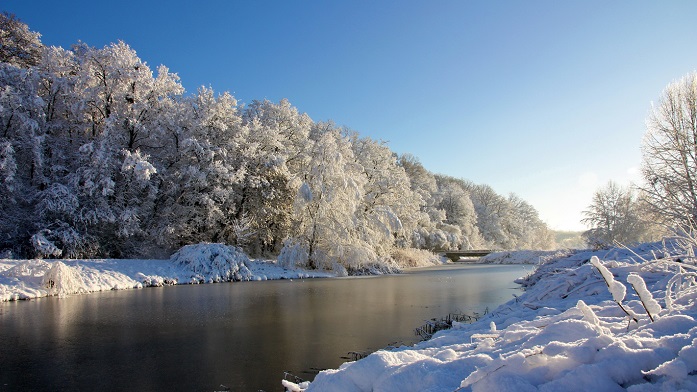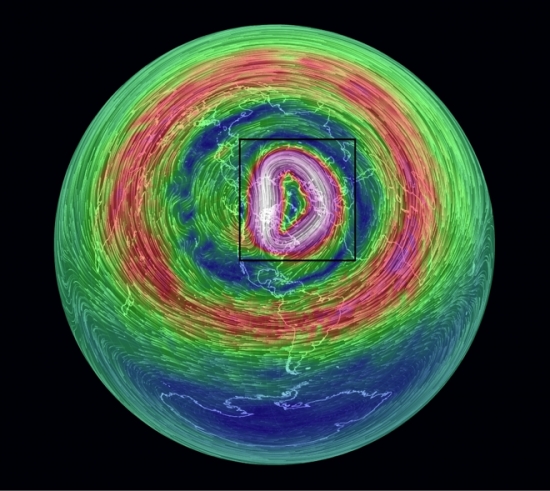Snowstorms Don’t Threaten Climate Science

Far from a challenge for climate science to overcome, the cold snaps in recent years across the northeastern US are predictable downstream effects of a warming world.
Given the harsh winters up and down the east coast of the US the past three years, it’s only a matter of time until an uncle, cocksure coworker, or armchair authority cites the cold to cast doubt on the science of climate change. Nevermind that the Lower 48 make up just one and a half percent of the earth’s surface area, which extends well beyond the snow-capped streets of Boston. The all-too-human tendency to interpret local conditions as indicative of a planetary trend prevails in uncritical circles.
But apart from the logical shortcomings of using the weather in your own backyard as an argument against climate change, the assumption that increased snowfall is inconsistent with a warming planet is also scientifically spurious. The glib refrain from talking heads that snowstorms disprove global warming — see Donald Trump’s colorful take as one example — amounts to another non sequitur undercut by well understood science.
Granted, if we rely on intuition alone, connecting these events may seem odd. So let’s move through this step by step to understand exactly how to square prolonged regional outbreaks of cold air with a globally warming world. Your uncle won’t listen, but that’s OK. We’ll press on anyway.
By now you will have heard a lot of talk about the polar vortex. Situated above each pole and extending into the upper layers of the atmosphere, it is home to some of the planet’s coldest air. Normally, this air is kept in place by the jet stream which surrounds it. So if we’re looking at the North Pole, the jet stream is the eastward circulation of air that rings the Arctic, separating the polar vortex from the lower (warmer) latitudes — what NASA calls the “aerial superhighway”. This region is a major weather system transport for North America.
The jet stream can vary in strength, powered by the temperature contrast between the Arctic and the tropics. A sharp temperature gradient will intensify the jet stream, and vice versa. Naturally, it’s at its strongest (with winds in excess of 100 mph) during the Northern Hemisphere winter when the temperature difference between the warm air coming up from the tropics and cold air from the sunless Arctic reaches maximum. The contrast is normally sufficient to barricade the frigid polar winds from dipping down into the mid-latitudes.
However, something sinister has altered the jet stream’s behavior. That something is human activities, namely the rapid release of greenhouse gases from burning fossil fuels and the clearing of forested land, the latter of which deprives the planet of a natural carbon sink. Because of the overabundance of CO2 and other emissions in the climate system, the Arctic region is warming at a rate twice the global average (known as polar amplification).
The feedback effects have manifested in the dynamics of the polar vortex and the jet stream formed along its boundary. What we are seeing is that the temperature contrast — between the cold air descending from the Arctic and the warm air rising from the tropics — has been sharply reduced with an inverse effect on air pressure, thereby slowing the jet stream. A weakened jet stream enables the mass of cold air usually confined to the poles — the polar vortex — to expand and reach down into the mid-latitudes of North America.
As the BBC explains: “If the differential is large then the jet stream speeds up, and like a river flowing down a steep hill, it ploughs through any obstacles – such as areas of high pressure that might be in its way. If the temperature differential reduces because of a warming Arctic, then the jet stream weakens and, again, like a river on a flat bed, it will meander every time it comes across an obstacle.”
This meandering air is conveyed by Rossby waves (a type of atmospheric wave), which increase in amplitude when the jet stream is destabilized. With these southward excursions lingering for weeks on end come an increased potential for major snowstorms across the northeast. All that is needed is sufficient moisture in the air, which there is now more of thanks to global warming, meaning greater snowfall totals when those storms do occur. It all starts with a diluted polar jet stream induced by an excess of atmospheric carbon.
While this instability drove the unusual cold snap in the northeastern US from the years 2013-15, it also brought warmer than usual temperatures farther north — to Greenland, Alaska, and much of the Arctic north of Canada — as the warmer air from the tropics surged northward, as well as prolonged drought conditions in California. (This past year, El Niño counteracted some of the weaker effects, bringing much needed moisture to California.)
Were we to step through this causal sequence seriatim, it would look something like this:
- The polar jet stream’s amplitude has increased, causing Rossby waves to penetrate farther south, bringing bitter-cold Arctic air and raising the likelihood for inclement weather.
- Its amplitude has increased because the jet stream has diminished in strength.
- The jet’s currents have weakened because the temperature gradient between the Arctic and the tropics has declined and associated air pressure has increased.
- The inverse effects on temperature and air pressure are the result of polar or Arctic amplification.
- The Arctic is warming two times as fast as the rest of the planet due in part to the rapid loss in ice mass concentrated around the North Pole, reducing albedo (reflectivity) in this region.
- The widespread melting of the cryosphere is happening because the planet as a whole is warming, setting off a series of feedbacks around the globe.
- The planet is warming because humans are emitting 36+ billion tonnes of CO2 from fossil fuels every year and clearing natural sinks at unprecedented rates.
And there you have it. Your uncle probably withdrew around word ten, but with any luck he’s amenable to a follow-up email later, at which point you can send this along.
TLDR: Climate change doesn’t mean Old Man Winter goes extinct. Seasons are still things that happen. And what we saw in the winter months of 2013-15 were predictable downstream effects of climate change on polar activity.
Update 9.25.2018: Anthony Hobley of Carbon Tracker has a great interview with Michael Mann, who breaks down jet stream science, Arctic amplification, and their impacts on the rest of the planet, including extreme weather events. Be sure to check it out.
Update 1.30.2019: Different year, same misconceptions. Amid willfully ignorant commentary from the usual suspects, I wanted to highlight this astute analogy from Climate Central’s Ben Strauss, drawing a distinction between weather and climate: “A cold snap in the teeth of global warming is no more unusual than a cool day in summer. Both happen,” said Ben Strauss, CEO and chief scientist at Climate Central, a science education non-profit. “It’s a bit like opening the freezer door — it cools you off if you stand there, but it tells you nothing about whether someone is turning up the room thermostat.”
Further reading:
- What Is the Polar Vortex?
- The science behind the polar vortex
- A Rough Guide to the Jet Stream
- Wobbly polar vortex triggers extreme cold air outbreak
- Polar Vortex Is Back: Coldest of the Cold En Route to U.S.
- How is the polar vortex related to the Arctic Oscillation?
- What Happened to the Polar Vortex?
- Polar vortex brings cold here and there, but not everywhere
- Unlike Vegas What Happens in the Arctic Doesn’t Stay in the Arctic says Prof Michael E. Mann
- Extreme cold gripping Midwest does not debunk global warming, experts say: “We ARE seeing an increase in record heat, and we are NOT seeing an increase in record cold,” Michael E. Mann, a professor of atmospheric science at Penn State, said via email. “The trend is in exactly the direction we would expect as a result of a warming planet. Over the past decade in the U.S., we have broken high temperature records TWICE as often as cold temperature records.”
- Are record snowstorms proof that global warming isn’t happening?: “No. Snowstorms require two things: moisture and freezing air temperatures. There are plenty of places where winter temperatures would have to rise by 10, 20, even 30 degrees Fahrenheit before it would stop snowing. Until then, snowstorms remain quite possible, and natural climate patterns and random variability will still lead to winters that are unusually cold and snowy in different locations…Earth has plenty of wiggle room before it warms so much that we will stop seeing snow anywhere in the winter.”
- The polar vortex has fractured, and the eastern U.S. faces a punishing stretch of winter weather
- Sudden Stratospheric Warming
- Explainer: The polar vortex, climate change and the ‘Beast from the East’
- Making sense of the polar vortex and record cold on a feverish planet
- What Is the Polar Vortex? And Other Cold-Weather Climate Questions



Comments